Module 1: Getting Started
Definition and scope of HR Analytics00:00
Importance of HR Analytics for organizations00:00
The role of HR Analytics in data-driven decision making00:00
Types of HR Metrics and KPIs00:00
How to develop and implement effective HR Metrics and KPIs00:00
Best practices for data collection and management00:00
Data quality and validation techniques00:00
Tools and techniques for data analysis and visualization00:00
Best practices for data interpretation and reporting00:00
Predictive Analytics For HR00:00
Types of predictive models for HR00:00
Overview of employee engagement00:00
Relationship between employee engagement and business performance00:00
Analyzing employee engagement using HR Analytics00:00
The role of HR Analytics in promoting DEI00:00
Best practices for analyzing DEI using HR Analytics00:00
Overview of talent management00:00
The role of HR Analytics in talent acquisition and retention00:00
Analyzing talent management using HR Analytics00:00
Overview of succession planning00:00
The role of HR Analytics in succession planning00:00
Overview of ethical and legal issues in HR Analytics00:00
Best practices for analyzing succession planning using HR Analytics00:00
Implications of HR Analytics for employee privacy and security00:00
Employee Performance Analytics00:00
Capacity Analytics00:00
Process Flow Capacity Analytics00:00
Recruitment Channel Analytics00:00
Introduction to HR Analytics & Predictive Modelling
What is analytics00:00
Analytics in the Employee life cycle00:00
Analytics Capabilities
Introduction to Big Data00:00
Analytics Value Escalator00:00
Data types in a Structured dataset00:00
– An Example…00:00
Introduction to Artificial Intelligence & Dashboarding
What is Artificial Intelligence00:00
Machine Learning and its Applications00:00
Way to Dashboarding00:00
Sample metrics for Dashboarding00:00
Sample issue use case Attrition Analysis00:00
Setup for Dashboarding using Tableau Public
Installation of Tableau Public00:00
Business Scenario00:00
Dataset description00:00
Dashboarding using Tableau Public in action
Loading the dataset into Tableau Public00:00
Building a Geo Map00:00
Saving the Tableau Project00:00
Stacked bar chart using hierarchies00:00
Creating a Bubble plot00:00
Creating a Pie Chart00:00
Creating an Area chart00:00
Creating a Treemap00:00
Creating a side-by-side circle chart00:00
Building the Dashboard – Part 100:00
Building the Dashboard – Part 200:00
Interactions between the two Dashboards00:00
Introduction to Predictive Modeling
Way to Predictive Modeling00:00
What do we mean by a model00:00
Sample issue use case Candidate success profile00:00
Translating Business model to Statistical Model00:00
Setup for Predictive Modeling using Microsoft Azure
Dataset description00:00
Creating an account on Microsoft Azure00:00
Loading the dataset into MS Azure00:00
Building a Predictive Model to predict Monthly Income
Data Preparation using MS Azure Edit Metadata00:00
Outlier TREATMENT00:00
missing values and feature selection00:00
Linear Regression Intuition00:00
Linear Regression using MS Azure00:00
Linear Regression using MS Azure – Part 200:00
How to Predict for new observation00:00
Decision Tree Intuition00:00
Decision tree using MS Azure00:00
Neural Network Intuition00:00
Neural Network using MS Azure00:00
Predictive Modelling to determine Candidate Success Profile
Classification using Decision Tree MS Azure00:00
Classification using Neural Network MS Azure00:00
Logistic Regression Intuition00:00
Evaluation Metrics00:00
Classification using Logistic Regression MS Azure00:00
Unsupervised Learning using MS Azure
Clustering using K-means Algorithm Intuition00:00
Clustering using MS Azure – Part 100:00
Clustering using MS Azure – Part 200:00
Application of Analytics in HR




